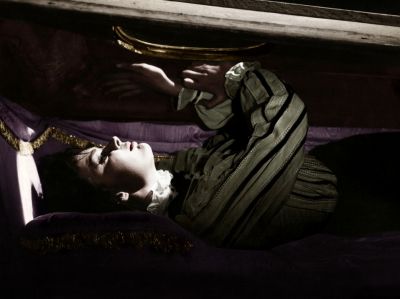
L'ORRIBILE SEGRETO DEL DR. HICHCOCK
(Italia/1962) R.: Robert Hampton [Riccardo Freda]. D.: 84'. V. italiana
T. int.: The Secret of Dr. Hichcock. Scen.: Julian Berry [Ernesto Gastaldi]. F.: Donald Green [Raffaele Masciocchi]. M.: Donna Christie [Ornella Micheli]. Scgf.: Joseph Goodman. Mus.: Roman Vlad. Int.: Barbara Steele (Cynthia Hichcock), Robert Fleming (dr. Bernard Hichcock), Montgomery Glenn [Silvano Tranquilli] (dottor Kurt Lang), Teresa Fitzgerald [Maria Teresa Vianello] (Margaretha). Prod.: Louis Mann [Luigi Carpentieri, Ermanno Donati] per Panda Film Da: Cineteca D.W. Griffith. 35mm. D.: 88'. Col. Versione inglese / English version
Per la prima volta Freda, realizzando un gotico di perfetta imitazione anglosassone, si firma con uno pseudonimo straniero (Robert Hampton) e con lui tutti gli altri collaboratori. L'idea sarà ripresa, tra gli altri, in vari horror e negli spaghetti western, da Sergio Leone in poi. Il film fu girato in dodici giorni in una villa di Roma, al quartiere Parioli. Il nome del dottore richiama ovviamente quello di Alfred Hitchcock, ma con una piccola variazione ortografica; nel successivo Lo spettro (1963), film quasi gemello di questo, torna un personaggio con questo nome, ma che non è esattamente lo stesso.
La forza di L'orribile segreto del dottor Hichcock e di Lo spettro, film controllatissimi e sapienti, sta nella loro claustrofobica e ristretta scenografia, nell'impasto sontuoso e cupo dei colori, ma soprattutto, per il primo, nella precisione analitica della descrizione di una perversione concreta, la necrofilia, e, nel secondo, nella concretezza di un 'a porte chiuse', di un gioco al massacro di quattro personaggi, dove il mistero si rivela beffa macabra, ma pienamente terrestre. Per Freda, ormai, i mostri sono tra noi, siamo noi, dominati dalle ambizioni e dalle paure.
Goffredo Fofi, prefazione a Riccardo Freda, Divoratori di celluloide, Il Formichiere, Milano 1981
L'orrore vero è quello radicato dentro di noi fin dalla nascita. È un terrore atavico che probabilmente risale ai primordi dell'uomo delle caverne. [...] Il primo vero terrore è quindi quello del buio... dell'oscurità! [...]. È questo il vero terrore, l'angoscia di ciò che non si vede, il rumore che scatena il terrore fino allora represso. In tutti i miei film vi sono porte che si aprono nel buio senza rumore, scricchiolii e fruscii raggelanti, il picchiettare di un ramo contro un vetro che sembra la mano scheletrica di un fantasma.
Riccardo Freda, Divoratori di celluloide, Il Formichiere, Milano 1981
While making a perfect copy of the Anglo-Saxon style gothic film, for the first time Freda signed with a foreign pseudonym (Robert Hampton), as did all of his collaborators. This idea was repeated in other horror films and spaghetti westerns, from Sergio Leone onwards. The film was shot in twelve days in a villa in the Parioli neighborhood of Rome. The doctor's name obviously echoes the name of Alfred Hitchcock but with a small difference in spelling; in the later work Lo spettro (1963), almost a counterpart to this film, there is also a character with this name but he is not exactly the same.
The strength of L'orribile segreto del dottor Hichcock and Lo spettro, two controlled and skillful films, lies in their claustrophobic and constricting sets, in the sumptuous, dark mixture of colors but especially, in the first, in the analytical precision of the description of a real perversion, necrophilia, and, in the second, in the reality "behind closed doors", a murderous game played by four characters, where mystery proves to be a macabre but earthly joke. For Freda, monsters are among us, are us, dominated as we are by ambition and fear.
Goffredo Fofi, preface to Riccardo Freda, Divoratori di celluloide, Il Formichiere, Milan 1981
Real horror is the one rooted in us at birth. It is an atavistic fear that probably goes back to the dawn of the caveman. [...] The first true fear then is the fear of the dark ... of obscurity! [...]. This is what true terror is, the anxiety of what cannot be seen, the noise that triggers terror previously repressed. In all my films there are doors that open silently into the dark, creaking or rustling, a branch tapping against a window that seems to be the skeletal hand of a ghost.
Riccardo Freda, Divoratori di celluloide, Il Formichiere, Milano 1981
Precede
MAGIA A PREZZI MODICI
(Italia/1956) R.: Riccardo Freda. D.:10'. V. italiana. 35mm. D.: 10'. Bn. Versione italiana / Italian version. Da: Istituto Luce Cinecittà
Giusto prima di inaugurare con I vampiri il cinema horror europeo, Freda realizza un ironico documentario sulla moda dell'occulto e del satanismo a Roma: "Il mio film mostrava dei veggenti, tutta una fauna parapsicologica assolutamente non seria. Ma il pubblico ci credeva, non si rendeva conto che era un film ironico".
Riccardo Freda
Just before inaugurating European horror film with I vampiri, Freda made a humorous documentary on the occult and Satanism in Rome: "My film showed clairvoyants, a whole parapsychological fauna that was not serious at all. But the audience believed it and did not realize that the film was ironic.
Riccardo Freda
Tariffe:
Aria condizionata
Info: 051224605











